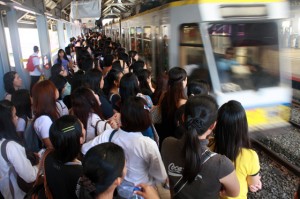Fares for the Light Rail Transit (LRT) 1 and 2 and Metro Rail Transit 3 (MRT) will go up starting January 4, 2015.
The Department of Transportation and Communications (DOTC) has finally decided to raise the fares for the three rail lines.
“It’s a tough decision, but it had to be made,” DOTC Secretary Joseph Emilio Abaya said on Saturday.
Abaya said the fare increase had long been proposed. “We delayed its implementation one last time until after the Christmas season. While 2015 will see increased fares, it will also see marked improvements in our LRT and MRT services.”
A base fare of P11 will be implemented. An additional P1 will be charged per kilometer.
The increase is in line with the 2011-2016 Medium-Term Philippine Development Plan (PDP), which directs the adoption of the “user-pays” principle in the pricing of transportation services.
Currently, the government allocates P12 billion a year to subsidize LRT and MRT operations.
Under the “user-pays” principle, riders will shoulder more of the cost for their own trips.
The fare hike entails a shift from the current zonal fare scheme to a distance-based system, meaning that commuters will be charged based on the distance they travel.
Since government subsidizes around 60 percent of the cost for each LRT passenger and around 75 percent of each MRT-3 passenger, an estimated P2 billion will be freed up to be used for development projects and relief operations.
“We must emphasize that around P10 billion will still go to subsidizing LRT and MRT passengers. But the premise of the user-pays principle is this: if what each rider pays is closer to the actual cost of his or her own trip, the P2-billion savings can be used for development projects and relief operations to benefit those who never even get to use the LRT or MRT,” Abaya said.
“I’m referring to the vast majority of Filipinos outside of Metro Manila—those in other parts of Luzon, in the Visayas, and in Mindanao, most especially those whose lives have been severely affected by typhoons and calamities. They will be the real beneficiaries of a more equitable distribution of these savings,” he added.
The last fare increase for LRT-1 was in 2003. LRT-2’s fares, on the other hand, have never been increased. As for MRT-3, fares were lowered: the minimum rate of P17 to a maximum of P34 in 1999 were decreased to P12 to P20 in 2000. At present, fares are even lower at a range of P10 to P15.
The failure to match fare adjustments with increasing operating costs resulted in practically break-even finances for all three lines, crippling their ability to invest in large-scale improvements for their facilities because revenues have only been enough for day-to-day operational requirements.
The DOTC, Light Rail Transit Authority and MRT-3 have pushed for improvement projects at the train facilities. A number of rehabilitation and upgrading works are set in 2015.
For instance, new light rail vehicles (LRVs) are already being manufactured to address long queues at MRT-3. The prototype unit will be delivered in August 2015, and after one month of testing, three to four additional LRVs will be delivered until all 48 units are operational. The headway or gap between train arrivals will also be faster, from the current three minutes to 2.5 minutes.
Also, six kilometers of MRT rail line will also be replaced, while the line’s signaling system and radio communications system will be upgraded.
A new 3-year maintenance contract is also being procured and will be awarded in the first quarter of 2015, and the new tap-and-go ticketing system for all three lines will be operational by September 2015 at the latest.
The common ticketing scheme or Automatic Fare Collection System (AFCS) will reduce queuing time and allow for seamless transfer between each line.
Meanwhile, LRT-1 operations are set to be turned over to the Light Rail Manila Consortium on or before October 2015, at which time work on the 11.7-kilometer Cavite Extension may begin. The LRT-2 line will also be extended by 4.2 kilometers, to Masinag, by 2017.


